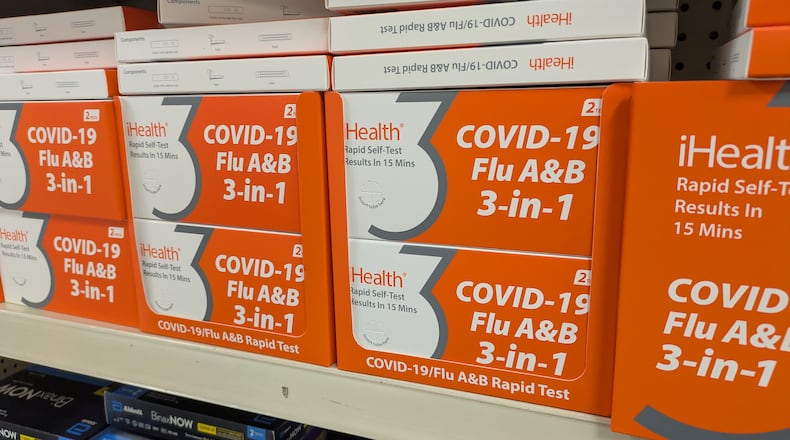There have been 22 flu hospitalizations in Montgomery County, according to ODH, and 11 hospitalizations in Butler County. Other Dayton-region counties have fewer than 10 hospitalizations, including four in Clark County.
The best protection against getting the flu is to get vaccinated, according to Public Health - Dayton and Montgomery County.
Credit: Bill Lackey
Credit: Bill Lackey
“It’s still not too late to do that, and that’s readily available at various locations and pharmacies throughout the area,” said Dan Suffoletto, public information manager at Public Health.
To find a vaccination location, visit vaccines.gov.
Ways to prevent the spread
In addition to getting vaccinated, practicing good hygiene techniques can limit the spread of flu.
“For people who are not sick and after you’ve gotten your vaccination, you want to continue to wash your hands thoroughly and frequently,” Suffoletto said. “You want to cover your mouth when you cough and sneeze.”
People can also clean surfaces in the high-traffic areas of their homes and/or limit time in large crowds, he said.
Some people who are more at risk for getting a severe case of the flu due to having a weakened immune system may also choose to wear a mask in public.
“Some individuals may choose to wear a mask to protect themselves, so you want to be mindful of that and understand that some people may, because of their medical condition, feel the need to take additional steps, including mask wearing, to help reduce their chances of getting sick,” Suffoletto said.
Those who are sick should stay home, he said.
“That’s not going to work, not going to school, not going to gatherings to try to isolate yourself to stop the spread to other people,” Suffoletto said.
What the Southern Hemisphere experienced
The flu season for the Southern Hemisphere of the world typically occurs between April and September, sometimes lasting until October or November. The Southern Hemisphere’s flu season is sometimes used as an indicator for what the flu season will be like in the Northern Hemisphere, which typically lasts around November through May.
During the 2024 Southern Hemisphere flu season, most countries experienced similar levels of flu activity compared to trends observed in prior seasons, like 2017-2019 and 2022-2023 flu seasons, the Centers for Disease Control said.
In South America, Chile, Ecuador and Uruguay saw high levels of severe flu-related disease, including hospitalizations, according to the CDC. Multiple countries in South America experienced flu activity that started and then ended earlier compared with flu seasons from before the COVID-19 pandemic, but were similar to trends those countries saw in 2023.
In Africa, most countries remained at low and moderate levels of influenza detections during the 2024 season, except for Zambia and South Africa, which saw high levels of flu-related hospitalizations.
Australia’s 2024 flu season had a similar start week compared to both pre-pandemic trends and the previous 2023 season, the CDC said. Flu activity briefly reached moderate levels but has been decreasing in recent weeks, though several jurisdictions continue to show increasing flu activity.
When to seek care
For those who get sick, more mild cases can be addressed by your primary care physician or at an urgent care in your area. Outpatient visits for flu-like symptoms increased by about 41%, according to recent ODH data.
Severe cases should seek care at a local emergency room. For adults, emergency symptoms can include:
- Difficulty breathing or shortness of breath.
- Chest pain.
- Ongoing dizziness.
- Seizures.
- Worsening of existing medical conditions.
- Severe weakness or muscle pain.
Emergency symptoms in children include all of the symptoms seen in adults, as well as:
- Gray or blue, lips or nail beds.
- Dehydration.
Accessing care for the uninsured and under-insured
For those who don’t have insurance, some uninsured consumers may be eligible for no- or low-cost health insurance through Medicaid or subsidized health insurance through the Marketplace. Enrollment is open for the Affordable Care Act’s Health Insurance Marketplace at healthcare.gov until Jan. 15.
Most Marketplace consumers are eligible for help paying the cost of their Marketplace plan, according to the Centers for Medicare and Medicaid. Depending on their household income, Marketplace consumers may be eligible for premium tax credits to help pay the costs of their monthly premiums and cost-sharing reductions for help paying their out-of-pocket health care costs like deductibles, coinsurance and copayments.
Federally qualified health centers (FQHC) also serve patients with no insurance, along with patients with Medicaid, Medicare or traditional insurance. In the Dayton region, the Community Health Centers of Greater Dayton and Five Rivers Health Centers are two local options.
You can use the Health Resources and Service Administration (HRSA) health center locator tool to find an FQHC by address, state, county or zip code at findahealthcenter.hrsa.gov.
About the Author


